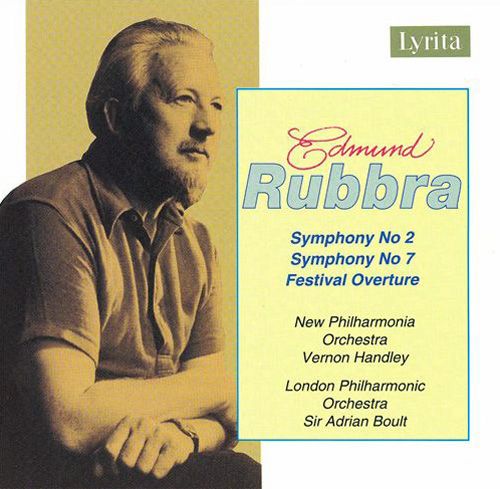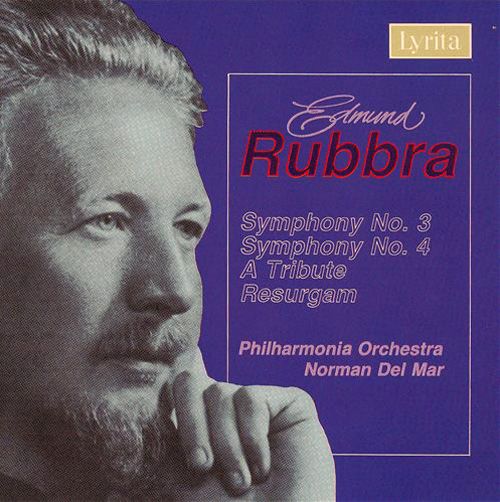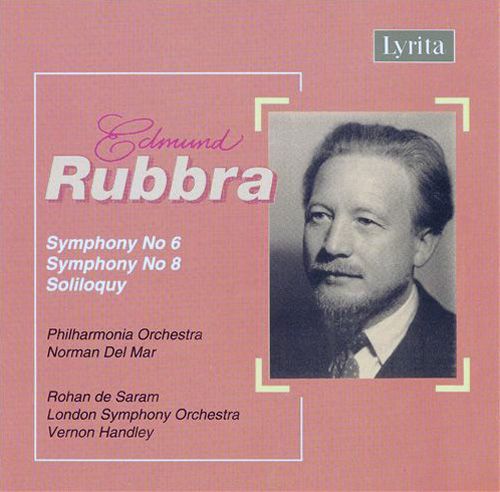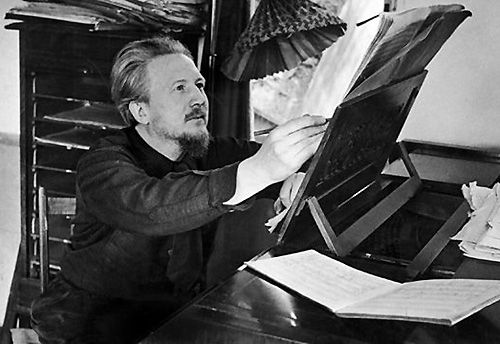wimpel69
04-16-2014, 09:28 AM
The sharing period for this selection has ended.
No more requests, and no re-ups, please!

Edmund Rubbra's (1901-1986) emergence during the interwar period as one of England's most skillful
symphonists, and the subsequent dissemination of his musical ideals through 40 years of teaching at major
British institutions, have earned him a place of honor among twentieth century British musicians. Rubbra was
born into an impoverished Northampton family in 1901. His mother gave him his first musical lessons at the
age of eight, and, although Rubbra was forced to take a job as a railway clerk at age 14, his enthusiasm for
music continued unabated. By 1917 he had discovered the music of Cyril Scott, and his subsequent recital of
that composer's piano works impressed the composer enough that he invited Rubbra to study both piano
and composition with him privately. After working with Scott for three years he attended Reading University
on a musical scholarship for one year (1920-1921), after which he entered the Royal College of Music to
study composition with Gustav Holst and harmony/counterpoint with R.O. Morris.
Rubbra's career was somewhat uncertain after graduating from the Royal College in 1925, and he was
forced to work in a number of capacities to make ends meet (teaching school, working as an accompanist on
a part-time basis, and writing reviews of new music for the Monthly Musical Record). By the mid-1930s,
however, Rubbra was beginning to make waves as a composer, and the premieres of his first three symphonies
(between 1937 and 1939) were sufficient to thrust him into the front rank of contemporary British composers.
Rubbra found professional stability with an appointment as lecturer at Oxford in 1947 (for which purpose he
made a thorough and insightful examination of both books of Bach's Well-Tempered Clavier), and in 1961
he was invited to join the composition faculty of the Guildhall School of Music, where he remained until the
1980s. His later years were marked by an increasing interest in Eastern spirituality, in conjunction with a
devout Roman Catholicism. Rubbra died in 1986.
Although a major facet of British musical life during the second half of twentieth century, Rubbra's music
has been sadly neglected by North American musicians. Rubbra developed his compositional voice slowly
and with great care, absorbing the myriad influences of British composers, from Holst and Vaughan Williams
to his childhood idol Cyril Scott, and eventually emerging with a musical language all his own. His later
music shows a keen awareness of sixteenth century polyphony (especially that of Monteverdi). The
11 symphonies (the ninth, entitled Sinfonia Sacra, for soloists, chorus, and orchestra) are
undoubtedly Rubbra's most significant contribution to the repertory.
This collection includes:
Symphony No.2, op.45
Symphony No.3, op.49
Symphony No.4, op.53
Symphony No.6, op.80
Symphony No.7, op.88
Symphony No.8, op.132
Overture "Resurgam", op.149
Soliloquy for Cello and Orchestra, op.57
Festival Overture, op.62
A Tribute to R.V.W., op.56



Music Composed by
Edmund Rubbra
Played by the
London Philharmonic Orchestra
London Symphony Orchestra
Philharmonia Orchestra
With
Rohan de Saram (cello)
Conducted by
Vernon Handley
Norman del Mar
Sir Adrian Boult
"The rigorously intellectual, vigorously contrapuntal, brilliantly colorful, and relentlessly spiritual
symphonies of Edmund Rubbra are not perhaps the first thing everybody thinks of when they think
of the typical twentieth century English symphony. Not for Elgar's heart-on-the-sleeve nobility or
Vaughan Williams' lump-in-the-throat sentimentality: Rubbra was strict, severe, and straight to the
point -- the point being that above all, Rubbra's symphonies were about head-in-the-sky sublimity
. Rubbra always has his eye on eternity, always aims to achieve the highest possible level of
contrapuntal rapture. And as these two superlative Lyrita recordings show, Rubbra more often
than not hits his mark. Vernon Handley with the New Philharmonia in the 1978 Second and
Adrian Boult with the London Philharmonic in the 1970 Seventh both know the full measure of
Rubbra's music, know its breadth and depth and heights, and can articulate its intensities and
immensities in performances of power and commitment. While not easy listening like Elgar or
Vaughan Williams -- imagine a leaner, lighter, modernist Bruckner and you have somewhat of
an idea of what to expect -- Rubbra should be heard by anyone with an interest in the twentieth
century English symphony."
All Music
"Start with the Con moto that opens the Fourth Symphony of Edmund Rubbra. If its combination
of stillness and anticipation, strength and tenderness, and clarity and mystery don't get you,
then you might as well forget Rubbra. But if it does -- and for anyone who's ever been touched
by the music of Vaughan Williams or Elgar, it probably will -- this disc of the English composer's
Third and Fourth symphonies plus his single-movement orchestral works A Tribute and Overture
Resurgam will be just the thing. Norman del Mar is a skilled conductor and a dedicated interpreter
and he obviously knows and loves Rubbra's music. The Philharmonia is a superb orchestra with
a radiant tone and a cogent ensemble and they're clearly ready to do whatever Rubbra's music
requires of them. What it requires is quite a bit and not all that much. On the one hand, it requires
immense intensity to make the lines glow and on the other hand it requires complete selflessness
not to get too overtly expressive. Del Mar and the Philharmonia give their all without going too
far -- and Rubbra's music shines with an inner light. Lyrita, one of the finest of the smaller English
labels, provides them all with absolutely transparent yet thoroughly atmospheric sound."
All Music
"Richard Hickox’s performances of these two symphonies for Chandos are very good; indeed, his
take on the first movement of the Sixth Symphony, so redolent of Sibelius’ Third, is a touch more
lively than that on offer here. But there’s no denying the general superiority of the orchestral playing
under Norman Del Mar, or Lyrita’s richer sonics (Handley and the LSO only appear in the Soliloquy,
very well played by Rohan de Saram). Yes, there are moments in the quicker sections of both
symphonies where the textures get a bit clogged, but that’s really the fault of the composer. Rubbra
fought the orchestra. While he clearly was a symphonist of substance, getting his message across
seemed to cause him no end of trouble. In these middle symphonies, however, the problems have largely
been solved, and along with Nos. 5 and 7 they constitute the essential core of his output. Symphony
No. 8, subtitled “Hommage to Teilhard de Chardin”, gives free rein to the spiritual impulse that
underlies so much of Rubbra’s art, and although the Hickox cycle is complete, if you just want to
sample this elusive (but very serious and ultimately worthwhile) composer, then this is the place to start."
Classics Today

Source: Lyrita CDs (my rips!)
Format: FLAC(RAR), ADD Stereo, Level: -5
File Sizes: 395 + 318 + 342 MB (incl. artwork & booklets)
The sharing period for this selection has ended.
No more requests, and no re-ups, please!
No more requests, and no re-ups, please!

Edmund Rubbra's (1901-1986) emergence during the interwar period as one of England's most skillful
symphonists, and the subsequent dissemination of his musical ideals through 40 years of teaching at major
British institutions, have earned him a place of honor among twentieth century British musicians. Rubbra was
born into an impoverished Northampton family in 1901. His mother gave him his first musical lessons at the
age of eight, and, although Rubbra was forced to take a job as a railway clerk at age 14, his enthusiasm for
music continued unabated. By 1917 he had discovered the music of Cyril Scott, and his subsequent recital of
that composer's piano works impressed the composer enough that he invited Rubbra to study both piano
and composition with him privately. After working with Scott for three years he attended Reading University
on a musical scholarship for one year (1920-1921), after which he entered the Royal College of Music to
study composition with Gustav Holst and harmony/counterpoint with R.O. Morris.
Rubbra's career was somewhat uncertain after graduating from the Royal College in 1925, and he was
forced to work in a number of capacities to make ends meet (teaching school, working as an accompanist on
a part-time basis, and writing reviews of new music for the Monthly Musical Record). By the mid-1930s,
however, Rubbra was beginning to make waves as a composer, and the premieres of his first three symphonies
(between 1937 and 1939) were sufficient to thrust him into the front rank of contemporary British composers.
Rubbra found professional stability with an appointment as lecturer at Oxford in 1947 (for which purpose he
made a thorough and insightful examination of both books of Bach's Well-Tempered Clavier), and in 1961
he was invited to join the composition faculty of the Guildhall School of Music, where he remained until the
1980s. His later years were marked by an increasing interest in Eastern spirituality, in conjunction with a
devout Roman Catholicism. Rubbra died in 1986.
Although a major facet of British musical life during the second half of twentieth century, Rubbra's music
has been sadly neglected by North American musicians. Rubbra developed his compositional voice slowly
and with great care, absorbing the myriad influences of British composers, from Holst and Vaughan Williams
to his childhood idol Cyril Scott, and eventually emerging with a musical language all his own. His later
music shows a keen awareness of sixteenth century polyphony (especially that of Monteverdi). The
11 symphonies (the ninth, entitled Sinfonia Sacra, for soloists, chorus, and orchestra) are
undoubtedly Rubbra's most significant contribution to the repertory.
This collection includes:
Symphony No.2, op.45
Symphony No.3, op.49
Symphony No.4, op.53
Symphony No.6, op.80
Symphony No.7, op.88
Symphony No.8, op.132
Overture "Resurgam", op.149
Soliloquy for Cello and Orchestra, op.57
Festival Overture, op.62
A Tribute to R.V.W., op.56



Music Composed by
Edmund Rubbra
Played by the
London Philharmonic Orchestra
London Symphony Orchestra
Philharmonia Orchestra
With
Rohan de Saram (cello)
Conducted by
Vernon Handley
Norman del Mar
Sir Adrian Boult
"The rigorously intellectual, vigorously contrapuntal, brilliantly colorful, and relentlessly spiritual
symphonies of Edmund Rubbra are not perhaps the first thing everybody thinks of when they think
of the typical twentieth century English symphony. Not for Elgar's heart-on-the-sleeve nobility or
Vaughan Williams' lump-in-the-throat sentimentality: Rubbra was strict, severe, and straight to the
point -- the point being that above all, Rubbra's symphonies were about head-in-the-sky sublimity
. Rubbra always has his eye on eternity, always aims to achieve the highest possible level of
contrapuntal rapture. And as these two superlative Lyrita recordings show, Rubbra more often
than not hits his mark. Vernon Handley with the New Philharmonia in the 1978 Second and
Adrian Boult with the London Philharmonic in the 1970 Seventh both know the full measure of
Rubbra's music, know its breadth and depth and heights, and can articulate its intensities and
immensities in performances of power and commitment. While not easy listening like Elgar or
Vaughan Williams -- imagine a leaner, lighter, modernist Bruckner and you have somewhat of
an idea of what to expect -- Rubbra should be heard by anyone with an interest in the twentieth
century English symphony."
All Music
"Start with the Con moto that opens the Fourth Symphony of Edmund Rubbra. If its combination
of stillness and anticipation, strength and tenderness, and clarity and mystery don't get you,
then you might as well forget Rubbra. But if it does -- and for anyone who's ever been touched
by the music of Vaughan Williams or Elgar, it probably will -- this disc of the English composer's
Third and Fourth symphonies plus his single-movement orchestral works A Tribute and Overture
Resurgam will be just the thing. Norman del Mar is a skilled conductor and a dedicated interpreter
and he obviously knows and loves Rubbra's music. The Philharmonia is a superb orchestra with
a radiant tone and a cogent ensemble and they're clearly ready to do whatever Rubbra's music
requires of them. What it requires is quite a bit and not all that much. On the one hand, it requires
immense intensity to make the lines glow and on the other hand it requires complete selflessness
not to get too overtly expressive. Del Mar and the Philharmonia give their all without going too
far -- and Rubbra's music shines with an inner light. Lyrita, one of the finest of the smaller English
labels, provides them all with absolutely transparent yet thoroughly atmospheric sound."
All Music
"Richard Hickox’s performances of these two symphonies for Chandos are very good; indeed, his
take on the first movement of the Sixth Symphony, so redolent of Sibelius’ Third, is a touch more
lively than that on offer here. But there’s no denying the general superiority of the orchestral playing
under Norman Del Mar, or Lyrita’s richer sonics (Handley and the LSO only appear in the Soliloquy,
very well played by Rohan de Saram). Yes, there are moments in the quicker sections of both
symphonies where the textures get a bit clogged, but that’s really the fault of the composer. Rubbra
fought the orchestra. While he clearly was a symphonist of substance, getting his message across
seemed to cause him no end of trouble. In these middle symphonies, however, the problems have largely
been solved, and along with Nos. 5 and 7 they constitute the essential core of his output. Symphony
No. 8, subtitled “Hommage to Teilhard de Chardin”, gives free rein to the spiritual impulse that
underlies so much of Rubbra’s art, and although the Hickox cycle is complete, if you just want to
sample this elusive (but very serious and ultimately worthwhile) composer, then this is the place to start."
Classics Today

Source: Lyrita CDs (my rips!)
Format: FLAC(RAR), ADD Stereo, Level: -5
File Sizes: 395 + 318 + 342 MB (incl. artwork & booklets)
The sharing period for this selection has ended.
No more requests, and no re-ups, please!